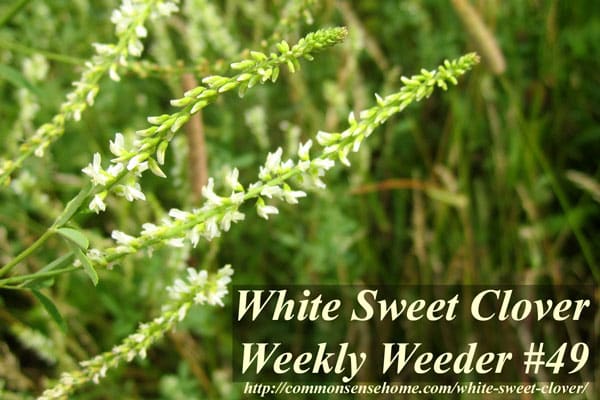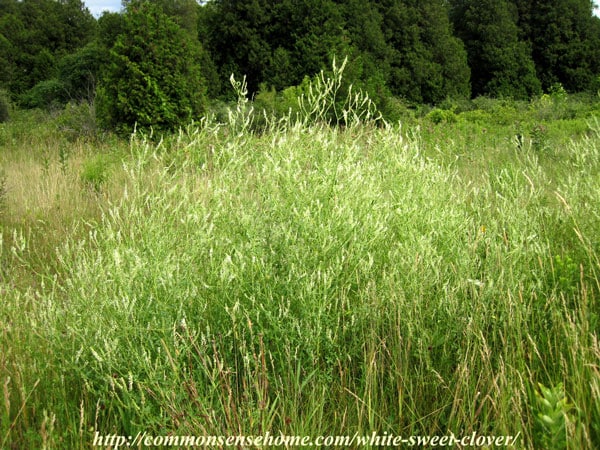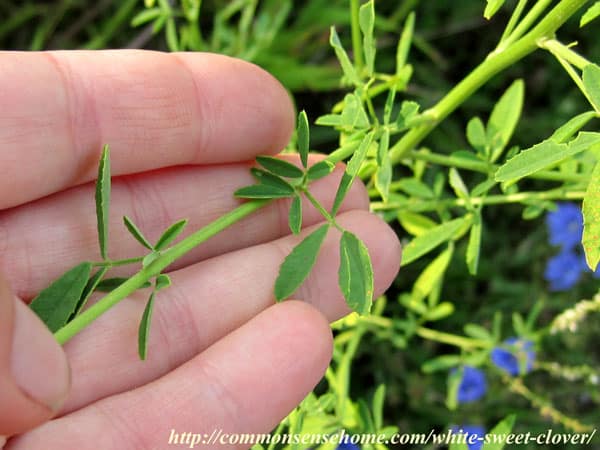White Sweet Clover – Weekly Weeder #49
This post may contain affiliate links. Read my full disclosure here.

Today’s featured plant is White Sweet Clover, Melilotus alba.
Note: Some guides treat yellow sweet clover, Melilotus officinalis, as a separate species, some group the two together under the name Mililotus officianalis. (See discussion of yellow and white sweet clover.) White sweet clover is also known as white melilot, honey clover, honey-lotus, tree clover, sweet clover, Bokhara clover, white-flowered sweet clover, and white millet. (source)
Range and Identification of White Sweet Clover
The USDA range map does not distinguish between yellow and white clover, shows them both throughout the continental United States and Canada. (USDA range map.) It is a non-native, introduced from Europe via Euarasia. It was once grown as a hay crop, but has been displaced by other forbs and grasses. It now grows wilds along roadsides and in open fields. In 2014, it is particularly abundant in our area of northeast Wisconsin, moreso than I have ever seen before. It prefers full soil and tolerates wet or dry soil, but not standing water.
This is a clump of sweet clover plants growing along the side of my driveaway. Plants grow 3-6 feet (90-180 cm) tall. Like other legumes, they add nitrogen to the soil.

The leaves are similar to alfalfa leaves, with alternating leaves that divide into three narrow leaflets.

White sweet clover flowers are very fragrant, with a vanilla-like scent. The flowers have been adding a wonderful perfume to my walks out to the mailbox and my time out in the garden. I let a couple of the plants grow in the main garden circle for the bees.
Sweet clover flowers are arranged in spike clusters at the top of the plant. Individual flowers are roughly 1/4″ (0.6 cm) across; flower spikes are around 8″ 920 cm) tall. The flowers are similar in shape to pea flowers (both plants are legumes), but much smaller. The seed pods are very small (3-4 mm or 0.12-0.16 inches), dark brown and vaguely egg-shaped. (See Wildflowers of Wisconsin for more information.)

White Sweet Clover as Wildlife Habitat
The flowers of sweet clover are a major source of nectar for honey bees due to their high sugar content. “Mellilotus” is Greek for “honey”, referring to the plant’s use as a nectar source.
Illinois Wildflowers lists faunal associations:
Would you like to save this?
The nectar of the flowers attracts many kinds of insects, including long-tongued bees, short-tongued bees, wasps, flies, butterflies, skippers, beetles, and plant bugs. Short-tongued bees also collect pollen. White Sweet Clover is considered an excellent nectar plant for Apis mellifera (Honey Bee) by beekeepers. The caterpillars of Blue and Sulfur butterflies feed on foliage, buds, or flowers, including Hemiargus isola (Reakirt’s Blue), Glaucopsyche lygdamus couperi (Silvery Blue), Colias philodice (Clouded Sulfur), and Colias eurytheme (Orange Sulfur). The caterpillars of the moth Scopula inductata (Soft-Lined Wave) feed on the foliage, while the caterpillars of Washia miscecolorella (Sweet Clover Root Borer Moth) bore into the stems and roots. Foliage is eaten by the White-Tailed Deer, Cottontail Rabbit, and livestock. However, improperly cured fodder that is derived from this and other Melilotus spp. (Sweet Clovers) can be mildly toxic to livestock. Some upland gamebirds occasionally eat the seeds, including the Greater Prairie Chicken.
Is White Sweet Clover Edible?
Eat The Weeds states:
The young leaves can be eaten raw, preferably before the plant blossoms. They are bitter and aromatic, usually used as flavoring in salads. The whole plant thoroughly dried can be used to make a tea with a hint of vanilla. The seeds can be used as a spice. Fermented or moldy clover should never be used. Lastly excess consumption can make you throw up. Use carefully and sparingly. Some people report getting a headache when they smell the plant.
Important note: Wet or moldy sweet clover can contain dicoumarol, a highly potent anticoagulant toxin. Avoid using wet or moldy sweet clover, and make sure to dry it out thoroughly before storing.
Medicinal Uses of White Sweet Clover
The primary medicinal constituent of white sweet clover is coumarin, which is an anticoagulant. (Coumarin is also found in cinnamon, tonka beans and dates.) Do not consume or use for medicine if you are on prescription anticoagulants. Always check with your doctor for possible interactions or concerns if you on are prescription medications, pregnant or breastfeeding. This article is for informational purposes only and is not intended to diagnose or treat any medical condition.
A Modern Herbal notes that sweet clover is used to relieve flatulence, so if you enjoy the flavor of the tea, a cup full may be an ideal gassy belly soother. It has also been applied topically as a poultice for aching joints, wounds and inflammation. (source)
Other Uses of White Sweet Clover
I found the other uses listed in The Modern Herbal even more intriguing. They note that in the past the flowers have been distilled to provide a type of flavoring, which has me wondering if it could be infused into a homemade extract. Like many strongly scented herbs, sweet clover has been dried and placed among the linens and clothing to deter pest infestations.
Perhaps the most interesting use is in a form of cheesemaking:
‘In Switzerland, Melilot abounds in the pastures and is an ingredient in the green Swiss cheese called Schabzieger. The Schabzieger cheese is made by the curd being pressed in boxes with holes to let the whey run out; and when a considerable quantity has been collected and putrefaction begins, it is worked into a paste with a large proportion of the dried herb Melilotus, reduced to a powder. The herb is called in the country dialect “Zieger kraut,” curd herb. The paste thus produced is pressed into moulds of the shape of a common flowerpot and the putrefaction being stopped by the aromatic herb, it dries into a solid mass and keeps unchanged for any length of time. When used, it is rasped or grated and the powder mixed with fresh butter is spread upon bread. ‘ (Syme and Sowerby, English Botany.)
I’m still not sure if I’d like to try this one out – it may be a recipe suitable for Fear Factor. Maybe they meant “fermentation” instead of “putrification”, and something was lost in the translation? Still, I think it’s pretty amazing that someone figured out how to make a shelf stable cheese product with dried clover powder.
Below is a video of a small white sweet clover patch from near our driveway. Sorry about the wind. It’s almost always blowing around here it seems.
Have you identified this wild plant in your area? What other wild plants are blooming near you this time of year?
You may also enjoy other posts in the Weekly Weeder series.

Love the weekly weeder thanks!
Thanks, Cortney. I love them, too, but they consistently get only small amounts of traffic. I will probably finish 52 posts on the site, and then work to expand the information and make it available in book and e-book form.
New to your blog and I too have begun to enjoy this section.
Will look forward to the e-book.
Welcome!